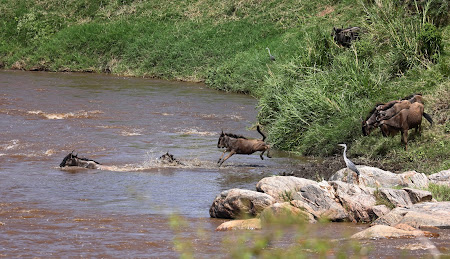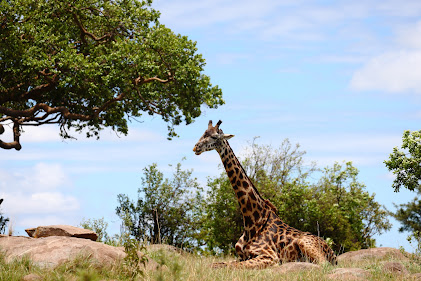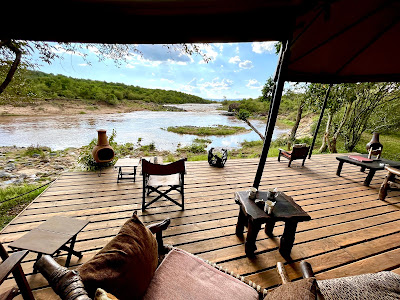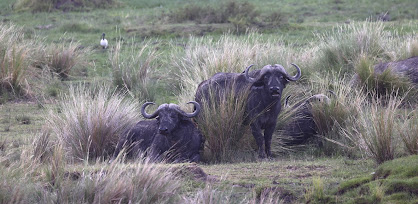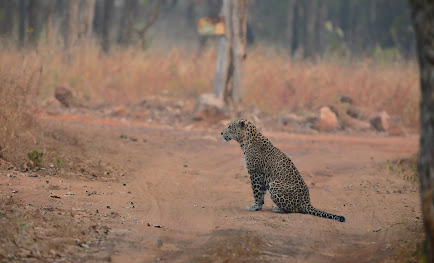William drove me to Isebania border, the Customs and Immigration post on Tanzanian side . I reached there around midday. Formalites were fast and I was out in 15-20 minutes. Mweta of Lion King Adventures was waiting for me outside. My Serengeti and Ngorongoro trip was organised and managed by Lion King Adventures.
Mweta, quite fluent in English and a very jolly guy , introduced himself . Born at a Serengeti neighboring village his wildlife career had started early at the age of 12 years. His father was also a Serengeti Park employee and that helped. Mweta has been working as a Game Drive guide and driver for the last 25 years and knows Serengeti very well. He told me that I would reach Heritage North Camp , my first night stay and stopover in North Serengeti , in about four and half hours.
For the second and third day in North serengeti I was to stay at Acacia Migration Camp.
North Serengeti's main attraction is river crossing when thousands of Wildebeest and Zebra jump into river Mara waters to reach the other side. Many perish in this perilous short journey due to huge Crocodiles which catch them in the waters and then by Lions and other lesser felines which ambush them when they step on terra firma on the other side. Though the reverse migration had already taken place this year but some was left still. I was to witness such an event.
I had an early breakfast next day morning and started game drive around 7.45 A.M. . North Serengeti landscape is quite different from Masai Mara. Unlike vast rolling plains of Mara, North Serengeti is flat, bushy, woody and has small escarpments. Central Serengeti also is more like this except that it is much drier and has hillocks called "Kopje "in Swahili . We often see "Kopjes" in Discovery and National Geographic images wherein Lion prides and other animal are depicted sitting high on rocks. Umbrella Acacia tree and Ant mound are found all over the landscape.
Mweta kept briefing me about African wildlife while driving. I was was keen to see Cheetah and Mweta promised me that . I still had another 2 days in North Serengeti.
My safari vehicle radio blared in Swahili. Mweta told that concentration of Wildebeest has been observed at the river and crossing will take place. We moved towards that side . It was around 11 am.
A herd of around 2000 Wildebeest and some 50 Zebra had gathered on the opposite side of the river. Mweta parked the vehicle from where the sliding path reaching down to river waters was perfectly in sight. He said that crossing will take place from that point only. He he was totally correct.
However the river crossing is a time taking and lengthy event. First a scout group of 3-4 Zebra and Wildebeest took rounds examining all crossing paths from safety point as the river is infested with huge crocodiles. That went on for hours till the animals found it safe to cross from the path just opposite to where I was parked.
About 6-7 Wildebeest jumped in the river and started swimming in order to cross the river. The rest of the herd didn't follow the suit. Instead they kept watching the progress of the advance group. Three of them reached to the opposite side but found the bank too high to climb up . While they struggled to climb up , the Crocodiles saw them . The rest of the Wildebeest who were in behind and were almost on the verge of finishing their crossing also saw the Crocodiles . They turned back swiftly and swam back to their point of start on the other bank.. The trio that was struggling to climb up the high bank was unlucky. Crocodiles grabbed them all.
I decided to wait. Mweta said that animals will regroup , try again but crossing could be from some other point along the river. I need to wait patiently.
In the meantime many tourist vehicle had gathered to watch the event. The park rangers also arrived at the scene to maintain order . Finally after a wait of about 3 hours , crossing seemed to start at a distant point which was about a kilometer away from where I was parked. Mweta said not to worry and moved the vehicle in that direction.
Hundreds of Wildebeest were ready to jump in the river and had gathered down the bank near flowing waters. I was ready with my camera to record the event but the frantic activity along the riverbank had caught attention of the Crocodiles and many of them appeared suddenly from nowhere. A pair of Hippopotamus also surfaced in the waters and that spooked the Wildebeest. The herd quickly climbed back to high river bank. The crossing was abandoned.
The time was 4 P.M. I already had a preview of the crossing. So I told Mweta to move on , There was much to explore in Northern Serengeti .
I got up late on the second day morning and game drive started around 8.30 A.M. While driving to the game viewing area , the vehicle radio blared and Mweta started clapping. He told me that Cheetah movement has been observed but that area is far off . It will take about 20 minutes to reach there. I was a bit skeptical. Finding a wandering Cheetah after 20 minutes or so in such a vast landscape ! Not possible.
But Mweta sounded very sure. He said that he would fulfill his promise made to me the other day. Since he knows the area like the palm of his hand , he would locate the animal for sure. I was still sceptical.
But Mweta was absolutely correct. He spotted the Cheetah and positioned the vehicle quite near to the animal so that I can take good shots.However the roof open safari vehicles have their limitations. You can not get eye level shot unless your object happens to be some big animal like an Elephant or a Giraffe. Window shots also suffer from the same limitation.
The Cheetah , a male , had made a kill short while ago and was in a hurry to devour its prey lest it was snatched away by Hyenas or Vultures swoop down upon it. It was a beautiful animal. I took shots and made a short video also. The blood stained uprooted grass in the front was telltale sign of the struggle that had ensued between the two
